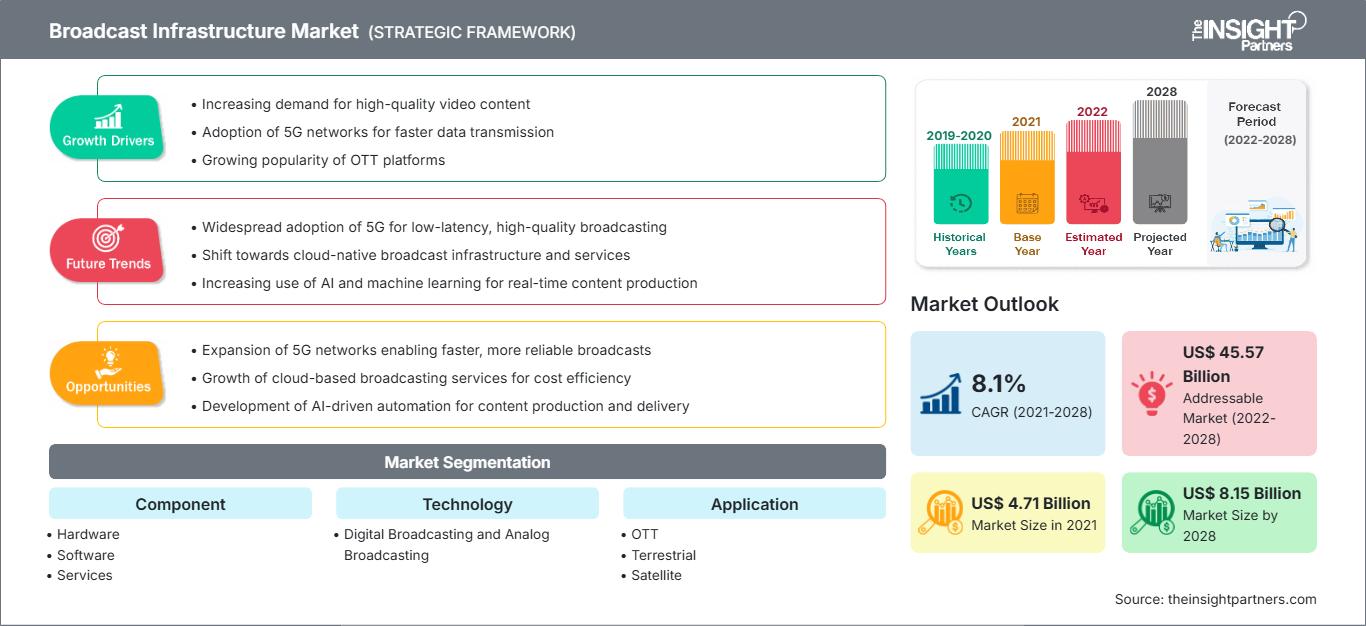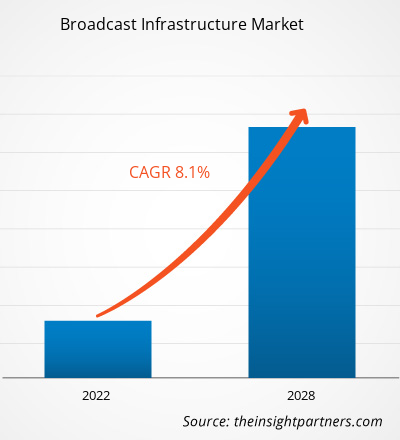[Rapport de recherche] Le marché des infrastructures de diffusion était évalué à 4 713,7 millions de dollars américains en 2021 et devrait atteindre 8 145,7 millions de dollars américains d'ici 2028 ; il devrait croître à un TCAC de 8,1 % entre 2021 et 2028.
Le changement de paradigme du secteur de la diffusion, de la technologie analogique à la technologie numérique, a introduit une infrastructure de diffusion avancée, relativement complexe. Le secteur de la diffusion connaît une forte demande pour de nouvelles technologies de diffusion telles que la télévision sur protocole Internet (IPTV), la télévision sur le Web, la télévision haute définition (HDTV) et le paiement à la séance. La demande d'expériences vidéo enrichies devrait ouvrir la voie aux diffuseurs du monde entier, en particulier en Asie. Un autre facteur clé du marché des infrastructures de diffusion réside dans les plateformes intégrées composées de serveurs, de décodeurs et de systèmes de protection de contenu vidéo, ainsi que des outils, intergiciels et systèmes de facturation appropriés. Ces plateformes permettent la fourniture de divers services de télévision sous différents formats, tels que la vidéo à la demande, le streaming et la télévision en différé, grâce à une combinaison de réseaux IP sous-jacents et de systèmes d'accès DSL ou optiques. De nos jours, les fournisseurs délaissent les infrastructures matérielles pour adopter des infrastructures logicielles en raison du coût élevé de ces infrastructures, de leurs coûts de maintenance élevés et de leurs fréquentes mises à niveau. Le secteur de la diffusion connaît des innovations révolutionnaires grâce aux avancées technologiques visant à offrir une meilleure expérience utilisateur et à créer des opportunités pour les fournisseurs d'infrastructures de diffusion.
Vous bénéficierez d’une personnalisation sur n’importe quel rapport - gratuitement - y compris des parties de ce rapport, ou une analyse au niveau du pays, un pack de données Excel, ainsi que de profiter d’offres exceptionnelles et de réductions pour les start-ups et les universités
Marché des infrastructures de diffusion: Perspectives stratégiques

- Obtenez les principales tendances clés du marché de ce rapport.Cet échantillon GRATUIT comprendra une analyse de données, allant des tendances du marché aux estimations et prévisions.
Durant la pandémie de COVID-19, un grand nombre de personnes travaillent à domicile, passent davantage de temps en ligne et se vantent du passage au numérique. Cette demande de ressources numériques met à rude épreuve les systèmes de plusieurs entreprises de logiciels et de plateformes et entrave leur capacité à fournir des services avec fiabilité et qualité. Cependant, l'épidémie de COVID-19 a eu un impact négatif sur les acteurs impliqués dans la diffusion de contenu vidéo aux utilisateurs finaux, en raison de la fermeture des entreprises et de la pénurie de main-d'œuvre. La crise de la COVID-19 a également radicalement bouleversé les opérations tout au long de la chaîne de valeur, des réseaux de fournisseurs à l'expérience de livraison client, en raison des fermetures d'entreprises, des interdictions de voyager et des perturbations de la chaîne d'approvisionnement.
Analyses du marché – Marché des infrastructures de diffusion : Adoption croissante des nouvelles technologies de diffusion
Avec l'amélioration continue de la numérisation et l'augmentation du revenu disponible, le marché connaît un taux d'adoption élevé de l'IPTV et de la TVHD. La demande d'expériences vidéo enrichies devrait ouvrir la voie aux diffuseurs du monde entier, notamment en Asie. La prolifération du haut débit s'accélère dans la région Asie-Pacifique, grâce au visionnage à la demande. De plus, les plateformes OTT (Over-the-Top) par abonnement, telles que Netflix, gagnent du terrain en Asie. L'augmentation des dépenses publiques consacrées aux infrastructures cloud, aux solutions cloud, aux services gérés et aux réseaux hybrides devrait stimuler la croissance du marché des infrastructures de diffusion. Les préoccupations croissantes en matière de sécurité et le maintien de la confiance des clients inciteront les diffuseurs à adopter de nouveaux modèles de diffusion. Toutes ces avancées et évolutions devraient avoir un impact positif sur la croissance du marché au cours de la période de prévision.
Informations sur les composants
Le marché des infrastructures de diffusion est segmenté en composants : matériel, logiciels et services. Le segment des logiciels détenait la plus grande part de marché en 2020.
Marché des infrastructures de diffusion
Les tendances et facteurs régionaux influençant le marché des infrastructures de diffusion tout au long de la période de prévision ont été analysés en détail par les analystes de The Insight Partners. Cette section aborde également les segments et la géographie du marché des infrastructures de diffusion en Amérique du Nord, en Europe, en Asie-Pacifique, au Moyen-Orient et en Afrique, ainsi qu'en Amérique du Sud et en Amérique centrale.
Portée du rapport sur le marché des infrastructures de diffusion| Attribut de rapport | Détails |
|---|---|
| Taille du marché en 2021 | US$ 4.71 Billion |
| Taille du marché par 2028 | US$ 8.15 Billion |
| TCAC mondial (2021 - 2028) | 8.1% |
| Données historiques | 2019-2020 |
| Période de prévision | 2022-2028 |
| Segments couverts |
By Composant
|
| Régions et pays couverts | Amérique du Nord
|
| Leaders du marché et profils d'entreprises clés |
|

- Obtenez le Marché des infrastructures de diffusion Aperçu des principaux acteurs clés
Les acteurs du marché des infrastructures de diffusion se concentrent principalement sur le développement de produits avancés et performants.
- En juin 2021, EVS, principal fournisseur de technologies vidéo en direct pour la diffusion et les productions de nouveaux médias, a annoncé son partenariat avec Gravity Media pour fournir le système de révision multi-caméras Xeebra comme technologie de base pour la nouvelle solution intégrée de communication et d'arbitrage vidéo de l'entreprise.
- En juin 2021, Ross Video a annoncé l'acquisition de Primestream, une société de solutions de flux de travail Media-Asset. Ces solutions sont utilisées par des clients de divers secteurs d'activité, notamment les entreprises, les médias numériques, le sport et la diffusion. Leurs solutions sont conçues pour résoudre les défis créatifs, commerciaux et technologiques uniques et de plus en plus complexes de chaque marché. Grâce à cette acquisition, Ross cherchera naturellement à combiner sa solution de gestion des ressources multimédias Streamline avec les produits Primestream au fil du temps, afin de créer une plate-forme de gestion des ressources graphiques et de production entièrement convergée.
Le marché des infrastructures de diffusion a été segmenté comme suit : Marché des infrastructures de diffusion – par composant
- Matériel
- Logiciels
- Services
Marché des infrastructures de diffusion – par technologie
- Diffusion numérique
- Diffusion analogique
Marché des infrastructures de diffusion – par application
- OTT
- Terrestre
- Satellite
- IPTV
- Autres ... par géographie
- Amérique du Nord
- États-Unis
- Canada
- Mexique
- Europe
- Allemagne
- France
- Italie
- Royaume-Uni
- Russie
- Reste de l'Europe
- Asie-Pacifique (APAC)
- Australie
- Chine
- Inde
- Japon
- Corée du Sud
- Reste de l'APAC
- Moyen-Orient et Afrique (MOA)
- Arabie saoudite
- EAU
- Afrique du Sud
- Reste de la MOA
- Amérique du Sud (SAM)
- Brésil
- Argentine
- Reste de la SAM
Marché des infrastructures de diffusion – Profils d'entreprises
- Cisco Systems, Inc.
- Clyde Broadcast Technology
- CS Computer Systems Ltd.
- Dacast Inc.
- EVS Broadcast Equipment SA
- Grass Valley
- Kaltura
- Nevion
- Ross Video Ltd
- Zixi
- Analyse historique (2 ans), année de base, prévision (7 ans) avec TCAC
- Analyse PEST et SWOT
- Taille du marché Valeur / Volume - Mondial, Régional, Pays
- Industrie et paysage concurrentiel
- Ensemble de données Excel
Rapports récents
Rapports connexes
Marché des équipements de diffusion IP en direct Surveillance dépendante automatique - Marché de la radiodiffusion Marché des solutions de surveillance du contenu de diffusion Marché du haut débit maritime Marché des systèmes de surveillance de diffusion Marché des émetteurs de radiodiffusion FM Marché des équipements de diffusion Marché des caméras de diffusion et de cinématographie numériques Marché des services à large bande par satellite La réalité mixte sur le marché de l'industrie audiovisuelle Marché des services de diffusion télévisuelle Marché des technologies de diffusion et des médias Marché des infrastructures de diffusionTémoignages
Raison d'acheter
- Prise de décision éclairée
- Compréhension de la dynamique du marché
- Analyse concurrentielle
- Connaissances clients
- Prévisions de marché
- Atténuation des risques
- Planification stratégique
- Justification des investissements
- Identification des marchés émergents
- Amélioration des stratégies marketing
- Amélioration de l'efficacité opérationnelle
- Alignement sur les tendances réglementaires
- Amérique du Nord




















 Obtenez un échantillon gratuit pour - Marché des infrastructures de diffusion
Obtenez un échantillon gratuit pour - Marché des infrastructures de diffusion